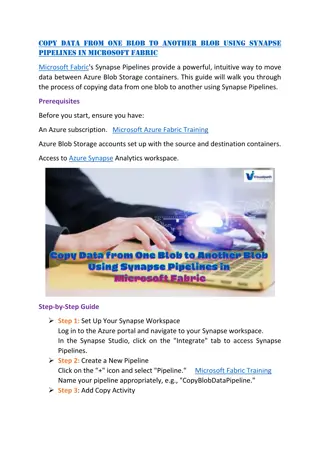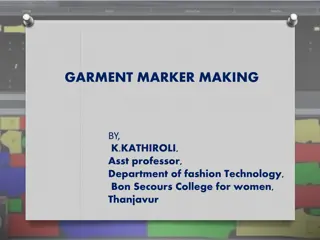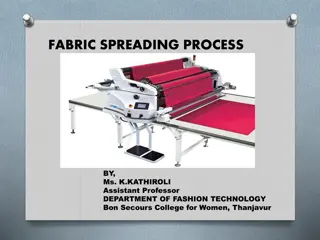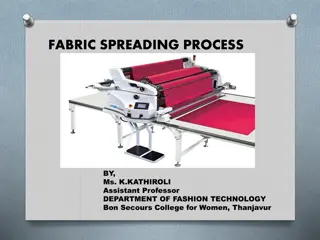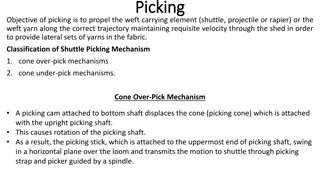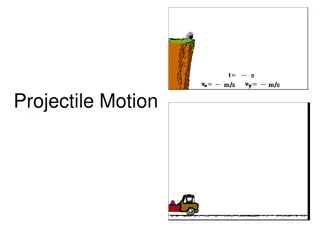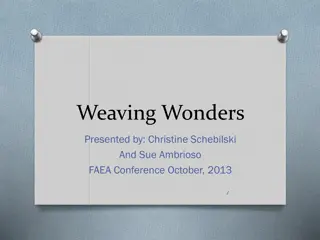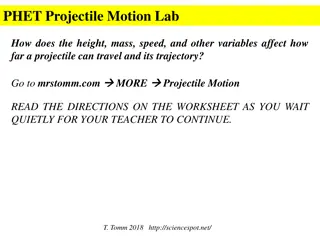Understanding Projectile Weaving Machines in Fabric Manufacture
Projectile weaving machines revolutionized fabric manufacturing with their unique weft insertion system. Introduced by Sulzer Brothers in 1953, these machines feature separate units for picking and projectile receiving, utilizing a gripper projectile to carry the weft thread without the need for winding. The energy for picking is derived from a torsion bar, ensuring precise acceleration for each pick. This method offers efficiency and precision in weaving commercial fabrics.
Download Presentation

Please find below an Image/Link to download the presentation.
The content on the website is provided AS IS for your information and personal use only. It may not be sold, licensed, or shared on other websites without obtaining consent from the author. Download presentation by click this link. If you encounter any issues during the download, it is possible that the publisher has removed the file from their server.
E N D
Presentation Transcript
FABRIC MANUFACTURE-lll Weft insertion by Projectile Weft insertion by Rapier Weft insertion by Air jet Weft insertion by other methods Weaving certain commercial Fabrics Non-woven Fabrics
Weft insertion by Projectile Features of projectile weaving m/c Advantages of projectile weaving m/c Weft Transfer from feeder to projectile Projectile picking mechanism Projectile Beat- up mechanism Selvedge formation
INTRODUCTION Sulzer Brothers, Suitzerland are pioneer of projectile weaving m/c projectile weaving m/c introduced in the market in 1953 The main feature of projectile weaving m/c lies in its weft insertion system Presently projectile weaving machines are marketed as Sulzer Ruti projectile weaving m/cs.
Projectile weaving m/c differs from conventional automatic loom by- its weft insertion system The method of beat-up and the projectile track shedding , take -up and let-off are almost same as that of conventional automatic looms
Main features of projectile weaving m/c The picking and projectile receiving units are separated from the sley. The sley carries the reed and and gripper guides The gripper projectile, made of steel,90 mm long 14 mm wide and 6 mm thickness weighs 40 grams. It carries the weft thread through the shed. The weft is directly drawn from a large stationary cross wound package .No need of weft winding.
Contd. The picking energy derived from the energy stored in a metal torsion bar which is twisted at predetermined amount and released to give the projectile a high rate of acceleration. Picking always takes place from one side. Projectile runs across the shed through a rake like steel guides, so that warp threads are touched neither by the projectile nor weft thread. Every pick is cut off at the picking side after weft insertion leaving about 15 mm from the edge.
Contd. The projected weft ends on both sides are tucked into the next shed by special tucking-in device and woven in next pick. The projected weft ends on both sides are tucked into the next shed by special tucking-in device and woven in next pick. The reed is not reciprocated as in shuttle loom. It rocks about its axis by a pair of cams. The reed and projectile guides are stationary during picking. A sley dwell of 255 degree at back centre enables the safe journey of the projectile.
Contd. Smaller depth of shed for smaller size projectile than shuttle as in shuttle loom. Weft insertion rate upto 900 to 1500m/min. is possible depending on type of loom and reed width. The colour changing mechanism is less complicated Facility to insert two picks in the same shed without the use of a dobby. In case of weft breakage the take-up beam and heald frames can be driven in reverse direction by a pick finding mechanism.
Advantages of projectile weaving m/c Two or three clothes can be woven simultaneously Breakage rate is almost 50% compared to shuttle loom. It may be due to smaller shed, reed with higher air to wire ratio and/or beat up line nearer to centre of the reed. Since the projectile passes through the shed there is no reed to projectile or projectile to yarn contact. With the four/six colour weaving machine the mechanical problems of conventional looms are eliminated.
Projectile Picking Mechanism features Different from conventional picking system Heavy wooden shuttle (approx.400g) is replaced by a 40g fine steel gripper(90mmx14mmx6mm) Weft is drawn directly from a large weft package (approx. 2 kg.).No weft winding required. Picking takes place from one side only. Picking energy is derived from the energy stored in a metal torsion bar, which is twisted at a predetermined amount and released to give a high rate of acceleration. Due to small mass of projectile compared to wooden shuttle, very high velocity is achieved ie twice as those in conventional shuttle.
Projectile Beat-up Mechanism Different from conventional beat-up using crankshaft, crank and crank arm Sley is positively rocked about its centre by means of matched cams A saddle carrying two antifriction rollers is attached to the sley and these rollers bear against the surface of the cams. There are several pairs of cams across the width of the sley The sley carries the reed and a no. of projectile guides Mass of the sley is about 16 kg (220 cm loom),small compared to that of shuttle looms
Contd. Projectile guides are used for the smooth movement of the projectile through the shed During beat up projectile guides move down the shed and lie below the cloth near the fell. Because of the cam operated sley it is possible to have a dwell period of 2550 at its back centre.









